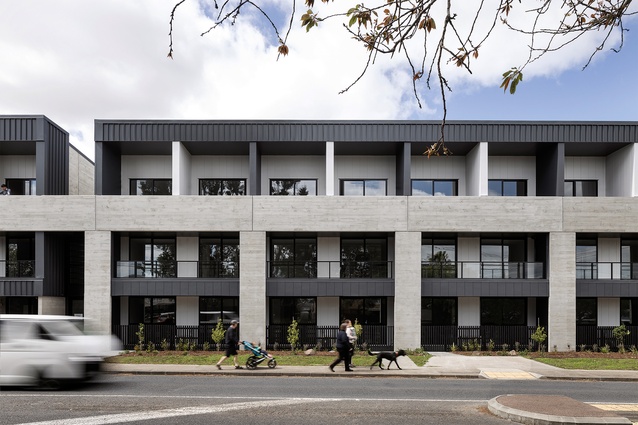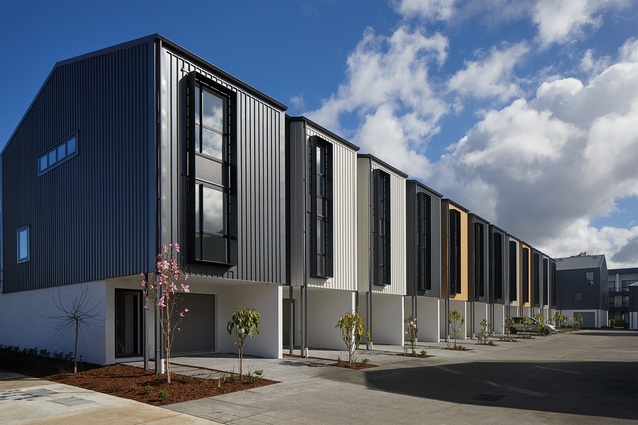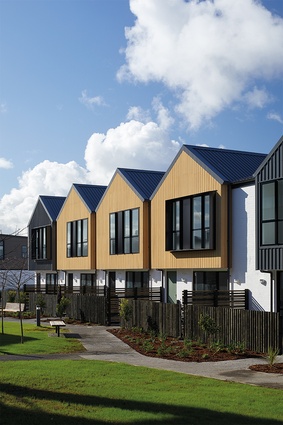Happy Days domain
Chris Barton explores DKO Architecture’s mix of terraced and apartment living, and its attendant cars, at Richmond, a former quarry site in Auckland’s Mount Wellington.
It’s not as bad as it sounds: a 2-bedroomed, 2-storeyed unit smack in the middle of a barren car park in between the backs of two rows of terraced houses. Strangely, these two pairs of 72sqm ‘Fonzie’ units are something of a design delight in DKO Architecture’s Richmond development in Auckland’s Mount Wellington – mainly in the way they break up the vast expanse of at-grade car-parking that inevitably dominates medium-density housing projects like this.
The term derives from Arthur Herbert Fonzarelli, better known as ‘the Fonz’ or ‘Fonzie’ – a character played by Henry Winkler in the 1970s’ US television comedy Happy Days, who lived in rooms above the garage of the show’s beloved Cunningham family. Oddly, it was in Queensland, Australia, in 2007, that the term started to be used, with ‘Fonzie flats’ proposed as a way to ease the housing affordability crisis.
So, it’s appropriate that the largely Australian firm of DKO, with offices in Sydney, Melbourne and Perth, plus Ho Chi Minh City, has brought a bit of Aussie across the ditch to its New Zealand offices in Auckland and Christchurch. But, while DKO architects talk of Fonzies freely, the term doesn’t seem to have stuck here, yet; the $695,000 units are marketed simply as “a great starter home, with two bedrooms”.

Instead of being over a garage, they’re over a vast car park, their own parking pad adjacent to each unit’s entrance that leads past a bathroom and stairwell to two ground-floor double bedrooms. Upstairs is a living room divided by the open stairwell from the kitchen-dining space that leads onto a generous balcony over one of the bedrooms below. From here, occupants can survey their car-park domain, helpfully providing sentry service for their terrace house neighbours’ cars.
The typology, reminiscent of mews houses, as seen in the row of three-storeyed brick dwellings in between two apartment blocks in the Architectus-designed Wynyard Central, gives the Richmond site a distinctly urban, rather than suburban, feel and puts the Fonzies, despite their backs-of-terraces-and-car-park vista, at the heart of this housing community.
The placement of the Fonzies also highlights the thorny issue of how to handle the massive space requirements that car-parking generates in a medium-density housing development. DKO’s Richmond 6 precinct – the second to be completed of seven in the Richmond subdivision of a 10.5-hectare former quarry site by Wilshire Group – covers just over a hectare. With a density of 58 units/hectare, the precinct features 47 terraced and 21 apartment dwellings plus an array of 60 garages and about 65 parking pads, all of which makes for a lot of cars. When complete, the whole area will comprise around 500 homes, similar to those of other former quarry site, medium-density developments such as Stonefields and Three Kings.
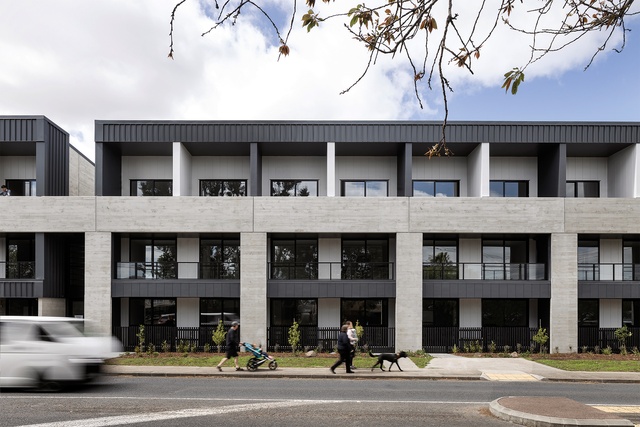
“It’s very car-centric,” acknowledges DKO Auckland director Ed Hosken. “But we can answer that. The cars don’t need views and they don’t need street addresses.” Hence the decision to give the bulk of the housing a street frontage. The terraces facing east front onto Tahuhu Road and a block of apartments facing north fronts onto Panama Road. To the west, three-levelled terraced units, each with a courtyard, front onto a retained bank, a remnant of the once-vast volcanic complex known as Te Apunga o Tainui or McLennan Hills: a series of scoria cones successively disappeared by extensive quarrying during the 1950s–1970s. The area was once part of the same volcanic system as nearby Ōtāhuhu, Mount Richmond, also known as the ‘Portage Volcano Complex’, that erupted around 40,000 years ago.
A linear pocket park, with fruit trees, flanked by a row of terraces on one side and another apartment block on the other, divides the huge Richmond 6 super-lot in the middle, creating two perimeter dwelling blocks that corral the car-parking tarmac into courtyards behind the buildings. “We push really hard to create an urban streetscape that’s not defined by cars,” says Hosken. “We want the buildings and living spaces to have all the prime qualities.”
Including the Fonzies, the development features a total of seven terrace designs; the largest being five four-bedroomed, 174sqm, two-levelled units, each with a 6.5m-wide frontage to the pocket park. Other terraces make up a mix of sizes. The largest is 158sqm over three levels with three bedrooms and was recently on the market for $855,000; the smallest is 103sqm with two bedrooms over two levels. Each terrace has a frontage of between 4.5m and 5.0m, resulting in a long rectangular plan of a dining-kitchen-living space on the ground floor and bedrooms on the upper level.
DKO has worked hard to make the exterior design diverse so each style of home is distinguishable. Each housing block offers a different roof form and a contrasting composition of materials and design features, including hooded windows, bagged blockwork, Trimrib and Multidek roof sheet, and Abodo Vulcan timber claddings to accentuate the individuality of each house.
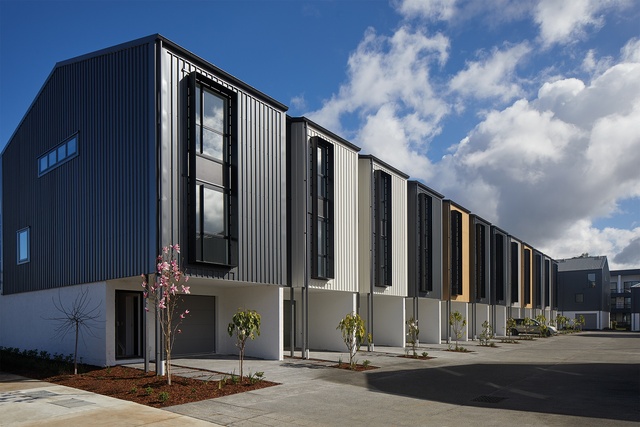
The two three-levelled apartment blocks, built of in-situ béton brut concrete displaying the timber imprint of its formwork, bring a slightly brutalist jolt to the northern compound. They’re notable for their innovative take on Le Corbusier’s Unité d’Habitation corridor arrangement – here, a row of two-levelled, 88sqm apartment units selling for around $695,000. Each apartment is accessed from one side of a single corridor on the second floor, and then joins to its upper-level living-kitchen-dining area on the third floor via its own internal stair.
This interlocking system of spaces, with the narrower upper level running over the corridor below creates a north-south, cross-ventilating dual aspect to each apartment. Below the two-levelled apartments, on the ground floor, is a row of 54sqm, one-bedroomed apartments, each with a 7.2m-wide frontage and 15sqm deck, currently on the market at $595,700. The northern apartment block also includes a gym.
It’s often said that really good architecture is all about the space between buildings and, here, that space is all about corridors – not so much as spaces but more as channels through which things, people and vehicles must pass. At Richmond 6, DKO skilfully weaves together an array of comings and goings: footpaths, streets, laneways, driveways, garages, parking pads, a pocket park and even a corridor, to make the communication pathways so vital to community work. Minding the traffic.



